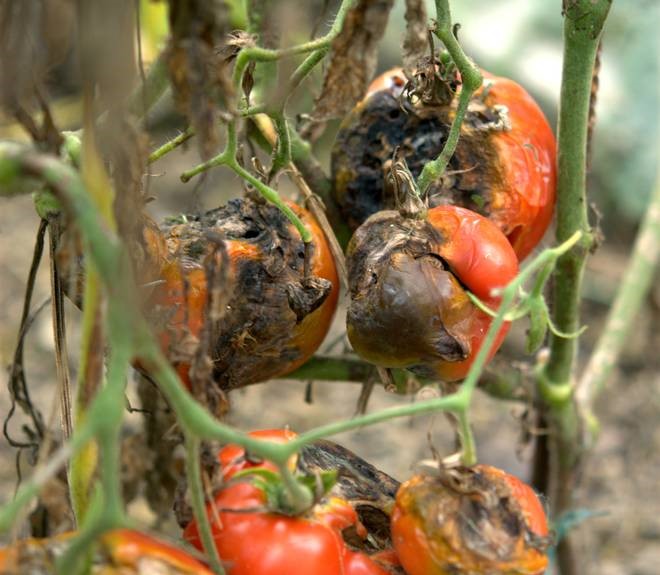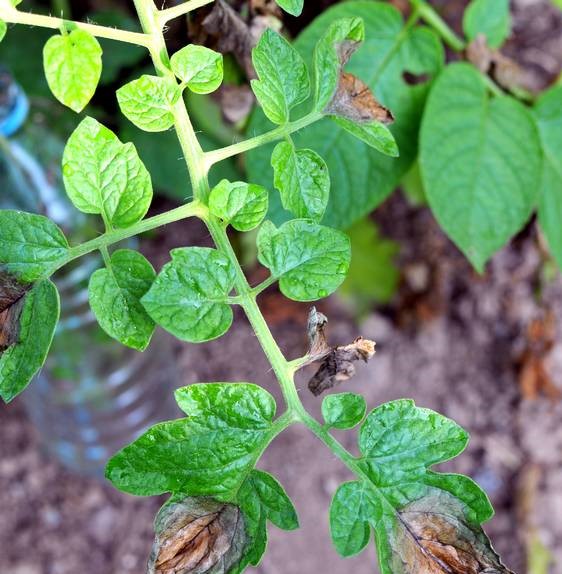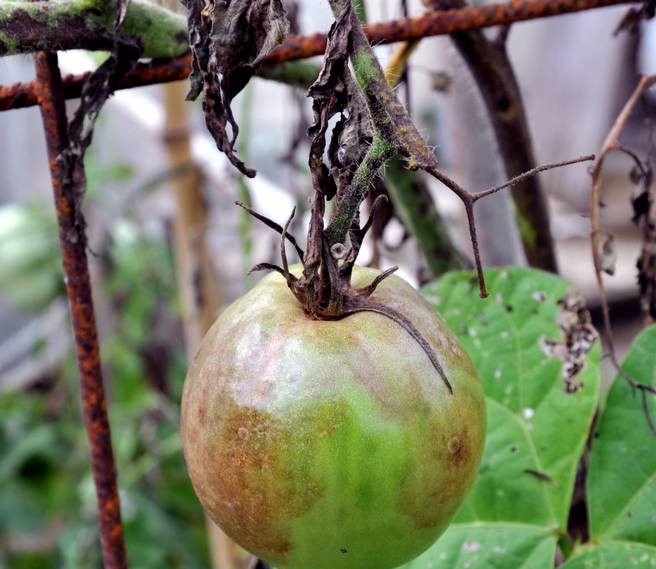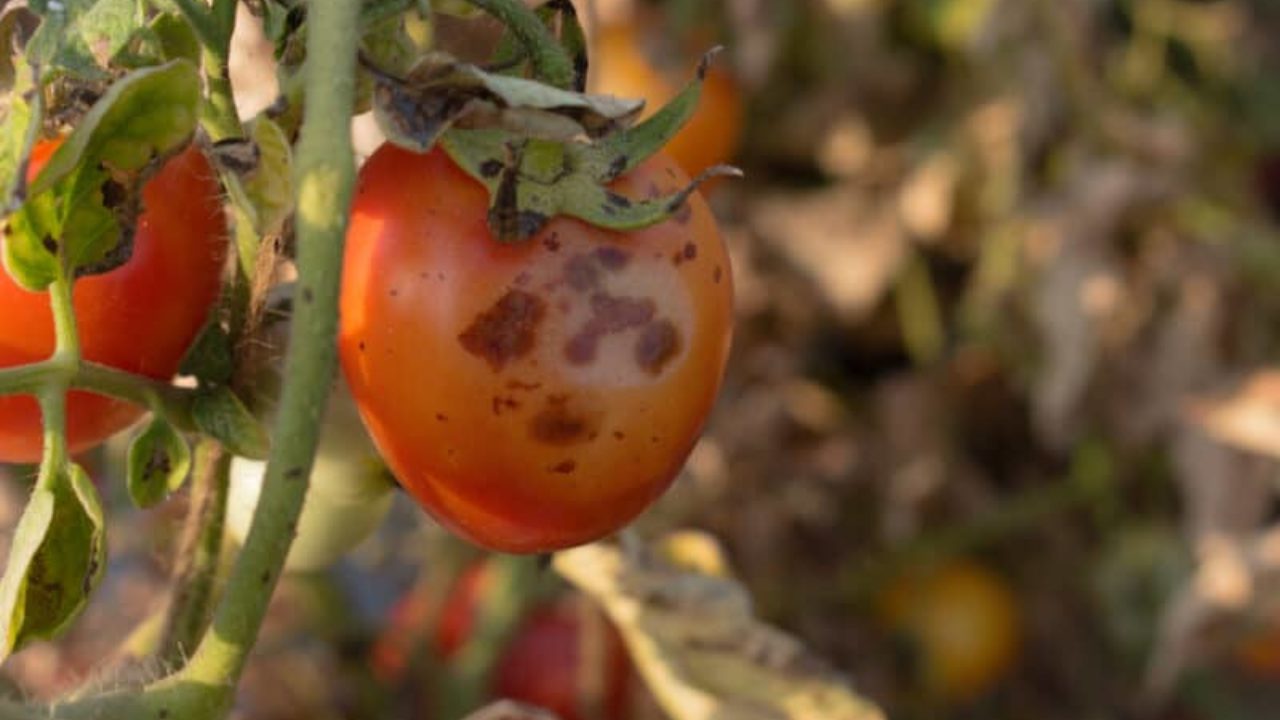
Humidity is the main enemy of tomatoes ! In hot and rainy weather, or with a stormy tendency, tomatoes are indeed more susceptible to diseases . The latter then progress very quickly if their development is not checked, going so far as to annihilate a picking which nevertheless promised to be promising. In this article, learn how to identify the main tomato diseases and find out how to prevent or stop them.
White spots on the skin of tomatoes
White or light spots appear on the side of tomatoes exposed to the sun. Without any real consequence on the harvest or the quality of the fruit, this phenomenon is similar to a “ sunburn ”. To avoid this, shade artificially or keep as many leaves as possible above the tomato clusters to filter out the sun and provide natural shade.
Clusters of dry flowers
The flower clusters develop normally but they dry up and fall off before fruit formation begins. Several factors can explain the problem encountered:
- The flowers may not have been fertilized at first for lack of pollinators. This phenomenon is commonly observed when tomatoes are grown under shelter or confined greenhouse and access is made difficult for bumblebees and pollinators.
- The soil or fertilizer inputs present a nitrogen/potassium imbalance in favor of the former. Nitrogen promotes shoot production; the plant then develops in abundance, offering many leaves, but in the end relatively few clusters of flowers.
- The watering is very irregular, in excess as well as the lack of water. Tomato plants under water stress, often associated with large temperature swings, can respond by giving up flower and fruit development.
Brown spots on young plants
Have you planted your young tomato plants in the last few days and suddenly brown spots appear on the stems or on the leaves? Do not panic ! Maybe it’s just because of the cold? Maybe you planted them too early, right?
You should know that a sudden drop in temperature, especially at night, is quite common in May. This freshness is even sometimes reinforced by gusts of wind or rainy weather. The tomatoes are chilly, they momentarily pause. If the brown spots don’t expand, they will lag but start growing again as soon as warmer days return. Otherwise, they will have to be replaced.
Remember! Always let the Ice Saints pass (May 11, 12 and 13) to avoid disappointment!
Yellow spots on top of tomatoes
The top of the tomatoes , around the peduncle, have large yellow spots . This part often remains hard and does not reach maturity. Not to be confused with a “sunburn”, this physiological problem reflects a potassium deficiency and occurs especially when tomatoes are grown on partially depleted soil. This is particularly the case for tomatoes installed in the same location (greenhouse, tunnel) as last year.
Tomatoes black ass
The end of forming tomatoes , opposite the peduncle, turns black or becomes covered with abnormal black spots that enlarge and become soft. Apical necrosis , or black bottom disease, is not a disease in itself, but rather a physiological problem whose appearance is consecutive to irregular watering associated with a lack of assimilation by the plant of Calcium. Some varieties, such as the Andean horned tomato , are said to be more susceptible. To prevent the problem, you can water the seedlings regularly with 10% diluted milk (100 ml for 900 ml of rainwater) or provide a handful of ash (or dolomite) when planting in the ground. . The “ black ass” of tomatoesis often confused with Alternaria , a fungal disease with similar symptoms. The black bottom, however, concerns only the end of the fruit.

Cracked tomatoes
Cracks or crevices appear on the top of tomatoes , near the peduncle, or concentrically on the fruit. The problem generally occurs after abundant watering, for example following a torrential rain storm. The tissues become waterlogged, then stretch and burst. The cracks are not really a problem insofar as they concern fruits close to maturity. They do, however, provide an open wound into which black bedbugs or fungal diseases quickly rush .
Large deformed tomatoes
The problem mainly concerns large tomatoes such as beefsteak and pineapple. It happens that the fruit deforms and that large cracks with hard skin are created: the Anglo-Saxons call this the catface (cat face).
This problem is caused by too low temperatures between the moment when the flower opened and when it was pollinated.
A cracked tomato does not return to normal. It continues to deform until its maturity. It is less pretty but its taste is not altered.
Black spotted white thumbtacks
In some years, small black bugs with white speckles invade tomatoes . They prick the skin of the fruit, creating small yellow spots and gradually dig into the epidermis to get into the tomato, when they simply do not take advantage of a crack to feed on the sweet flesh. These small insects are the larvae of the green bug (Nezara viridula). They are more numerous from year to year, thanks in particular to global warming, the effects of which are beginning to be perceived. Apart from regular collection, by hand, there is no radical solution to put them to flight.
Green and pink aphids under the leaves
Green and pink potato aphids ( Macrosiphum euphorbiae) may also colonize tomatoes (both plants belonging to the same nightshade family).
This problem occurs especially when the soil is too rich in nitrogen. These small insects reproduce very quickly. They excrete a sticky honeydew which covers the leaves but also the first tomatoes in formation. The problem tends to be regulated naturally with the arrival of the first heat and the appearance of auxiliary insects.
In case of heavy infestation, however, you can do a treatment with black soap diluted at 20% in rainwater and added with a teaspoon of rapeseed oil.
Small white flies: whiteflies
Kinds of small white flies find refuge on the underside of the leaves and fly away in clouds at the slightest movement of the twigs. These attacks are particularly observed when tomatoes are grown in tunnels, shelters or greenhouses, especially when the atmosphere is confined. Spray a solution based on black soap, several days apart if the problem persists. Also avoid growing plants known to be susceptible to whitefly attacks in the immediate vicinity of tomatoes : cabbages, cucumbers, pelargoniums or fuchsias. Hang glue traps in greenhouses, tunnels and shelters to quickly detect adult theft.
Worms eat the roots
In a hot and humid atmosphere, tomatoes sometimes suffer attacks from nematodes , microscopic worms which parasitize the roots and cause the plant to die back. If it is difficult and unreasonable to treat the soil, the privileged association of tomatoes with marigolds and marigolds, in addition to being aesthetic, has proven its effectiveness. These annual flowering plants are indeed excellent nematode repellent plants !
Caterpillar or tomato moth
Green caterpillars devour the insides of growing tomatoes . The migratory butterfly of tropical origin responsible for the damage is a moth (or armiger). Its populations are especially significant in heat waves, which unfortunately become more and more frequent due to global warming.
Essentially nocturnal, the female then lays her eggs on the fruits. The hatching larvae bore into the skin and burrow into the fruit. The caterpillars thus grow in the shelter, feeding on the flesh before it is fully mature. Treat preventively with a Thuringian Bacillus solution. Scratch the ground regularly in winter to disturb overwintering larvae and expose them to natural predators (birds).
Spiders, spider mites
Tomato leaves are covered in tiny yellow dots . Fine cobwebs are also visible, especially in the folds of the underside of the leaves. Spider mites are small mites (less than 1 mm long). They cause damage and multiply rapidly at the end of summer, taking advantage of hot and dry environments. They then bite the leaves, causing their characteristic gradual discoloration. These little insects hate water! If it is not reasonable to regularly spray the foliage of tomatoes, under penalty of seeing them develop cryptogamic diseases, you can still treat with a decoction of garlic (70 g of minced garlic for 1 L of water, leave to infuse for 1 hour and then dilute to 30%) or with white oil (20 ml of oil of rapeseed, 4 drops of black soap, 1 L of water) to eliminate them.
slugs
Characteristic translucent and sticky streaks can be seen on the leaves, which have been partially or completely eaten! Slug attacks mainly concern young plants in pots or just transplanted. Some varieties, especially the cherry tomato, are more prone to attack. To fight and limit the impact of molluscs, draw from the classic panoply of the warrior gardener: beer trap, ash line, collection by hand, blue or white pellet trap, ferramol…

Tomato late blight
This is probably the most dreaded tomato disease ! Favored by high heat and high humidity, some summers, tomato late blight ( Phytophthora infestans ) gallops from foot to foot, showing up as irregular spots that are initially yellow on the leaves, before they turn brown and dry afterwards. The stems and petioles are also affected, in turn presenting large brown spots. Finally, the fruits are lastly concerned: near the peduncles, large blackish and hard spots form which deform the tomatoes .and end up completely rotting them. To limit their appearance, some gardeners cross a copper wire at the base of the stem of the tomato: it would release copper in the sap, playing the same role as Bordeaux mixture. The effectiveness of this trick has not been demonstrated.
Early blight: brown leaves
The leaves are covered with brown to black spots surrounded by a yellow halo. Stems may show the same symptoms. Then the fruits are hollowed out with black spots, which make them unfit for consumption.
gray rot
Brown, dry cankers appear on the stems. The leaves, in turn, become covered with brown spots and a characteristic filamentous grayish down. The fruits are also affected by large soft spots of rot.

How to avoid tomato diseases? 10 good practices…
- Prioritize crop rotation and plant associations. For example, avoid cultivating Solanaceae (chili, pepper, eggplant, potato) together or in succession. As late blight also attacks potatoes and possibly persists from one year to the next in the soil or in the tubers, never grow tomatoes with or after diseased potatoes !
- Strengthen the natural defenses of tomato plants by regularly spraying nettle manure. Well-nourished plants are always more resistant to diseases!
- Do not plant the tomatoes too close together (50 cm minimum distance). Fungal spores are transmitted more easily when the leaves are in contact.
- Prune and eliminate diseased parts and damaged tomatoes without delay. Do not pour this contaminated waste into the compost heap, the fungus spores can remain there all winter and contaminate future plantings.
- Always water the plants at the foot, without touching the foliage, preferably early in the morning or in the evening. The spores take advantage of the smallest drops of water on the leaves to germinate.
- Against cryptogamic diseases , spray horsetail manure every 15 days if the season is hot and humid. This organic alternative to Bordeaux mixture, rich in silica, is mainly used for prevention. It stimulates immune defenses and blocks the germination of disease-causing spores.
- If you grow tomatoes in a greenhouse, tunnel or shelter, ventilate as soon as possible to avoid a confined atmosphere and limit the condensation that humidifies the leaves in the morning.

- Organize regular watering, twice a week during the growth period, reduced to one watering from the fruiting stage. Mulch to limit the drying out of the soil and avoid black cul disease.
- When sowing, only use seeds from healthy fruits and plants.
- To reduce the number of “gateways” for diseases , avoid pruning tomatoes as much as possible and removing “greedy” ones. Cherry tomatoes, for example, naturally develop a bushy habit which in no way disturbs fruiting. On the contrary, it is often better without pruning, sometimes only a little later.

